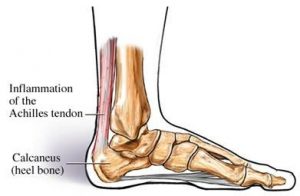Achilles Tendinopathy
What is Achilles Tendonitis and Tendinopathy?
Achilles tendonitis is a condition characterized by acute inflammation of the Achilles tendon. As foot experts, we no longer use this term as is doesn’t accurately describe what is happening (given there is more to it that just ‘inflammation’). “Inflammation of the tendon,” is actually a normal tendon healing response which can cause some tendon pain. This is known as the reactive phase and is a good tendon healing response
Achilles tendinopathy is more accurate and characterized by causes pain, stiffness, and loss of strength in the affected area which is predominately located at the posterior aspect of the heel bone and usually consists of a rapid onset followed by direct trauma or sudden excessive overuse. Consequently, significant inflammation can be seen and felt including redness, heat, swelling and pain with movement.

The Achilles tendon responds to repetitive overload by inflammation followed by progressive injury followed by degeneration.
A: Reactive tendinopathy (Stage 1, Image A) begins when there is a rapid increase of stress/loading to the tendon. The tendon is structurally intact and there is no permanent change to the collagen integrity. However, if the loading continues with inadequate rest the tendon develops to stage 2.
B: Tendon Dysrepair (Stage 2, Image B). This is where structural changes to the tendon is seen with neurovascular growth. It is during this stage that the load/stress through the tendon is outweighing the recovery rate of the tendon which limits it’s healing ability.
C: Degenerative tendinopathy (Stage 3, Image C). Finally, as the condition adversely progress, the collagen become disorganised and loses the linear orientation required to function. This is classified as degenerative tendinopathy which further neurovascular growth, thickening of tendon and nodular formation can be seen. This effectively leads to ‘cell death’ and leads to long term issues which are hard to reverse.
D: Tendon rupture (Stage 4). This involves the tendon tearing which leads to loss of function, inability to push off with your foot and requires immobilisation followed by surgical repair and appropriate rehabilitation.
Symptoms of Achilles tendon pain includes:
 Pain at the back of the heel bone.
Pain at the back of the heel bone.- Pain can radiate upwards to the Achilles tendon at approximately 2-6cm above heel bone and calf muscle belly.
- Swelling and pain at palpation at Achilles tendon and/or back of heel bone.
- Pain tends to exacerbate with upward foot movement and worsens with use of the tendon.
- Can feel sharp, stiff and somewhat like a pulling/crunchy sensation particularly in the morning.
- Can develop swelling, thickening, scar tissue +/- nodule formation.
Incidence Rates
Achilles tendinopathy effects competitive and recreational athletes as well as people who are not active. Over 80% of tendon tears occur during recreational sports. Observational data suggest that competitive athletes have a lifetime incidence of Achilles tendinopathy of 24%, with 18% sustained by athletes younger than 45 years. Among competitive runners, the lifetime incidence of Achilles tendinopathy may be as high as 40-50%. The incidence of Achilles tendon rupture in the general population is approximately 5-10 per 100,000.
Who is at risk of developing it?
Excessive loading of the tendon during vigorous training activities is the main pathological reason to develop Achilles injury. Various activities and factors can place you at risk of developing Achilles tendinopathy including:
- Runners, endurance and high intensity sports – excessive training and inadequate rest.
- Pronatory gait – moderate to severe ‘rolling in’ of feet when walking.
- Instability at outer ankle – history of twisting ankle outwards.

- Lack of flexibility at lower leg and foot muscles.
- Dysfunctional (weak +/- tight) calf muscles.
- Poor vascularity in lower leg and feet.
- Family history of Achilles tendinopathy.
- Changes to training patterns and surfaces.
- Poor footwear.
- Poor training techniques.
- History of foot injuries.
- Those with high BMI.
What are treatments used to manage Achilles tendinopathy?
A combination of treatment methods may be required to achieve the quickest and most effective outcome. Your podiatrist will organise a treatment plan best suited for your symptoms, biomechanical findings and lifestyle needs.
- Stage 1 treatment protocols:
- Relative rest and modified activity – All high impact and high intensity activities should be reduced to low impact until you are pain free.
- Strengthening and stretching exercises – Improving your tendons strength is crucial and our podiatrist will develop a suitable soft tissue program.
- Footwear – It is essential you are wearing footwear specific to your foot type. Following an assessment, your podiatrist will recommend suitable footwear.
- Stage 2 and 3 treatment protocols:
- Strengthening and stretching exercises.
- Structured return to activity program – Imperative in only progressively loading the tendon without reinjuring it to avoid going backwards in your recovery.
- Footwear – This applies to ALL the shoes you are wearing as they all contribute to the pain and recovery. Different feet require different shoe options – changing this alone can resolve your pain!
- Orthotic therapy – Orthotics can be useful to realign the foot position into an ideal posture, thus reducing stress placed upon the Achilles tendon by poor foot function.
- Shockwave therapy – Accelerate and facilitate healing while providing immediate pain relief.
- Dry needling – Correct and ease muscle imbalance and tightness. Improve muscle coordination and function.
- Injection therapy – Aim is to stimulate inflammation in order to increase circulation and collagen deposition, decrease pain and improve tendon function.
Take home message: Given the poor blood supply around the Achilles tendon, early attention is crucial as treatment can become more complicated and less predictable due to the poor healing nature of this condition. If your Achilles tendon pain continues to persist and no improvements are seen after self-treatment, contact us and see a podiatrist quickly who can help you get back to your lifestyle pain free!
